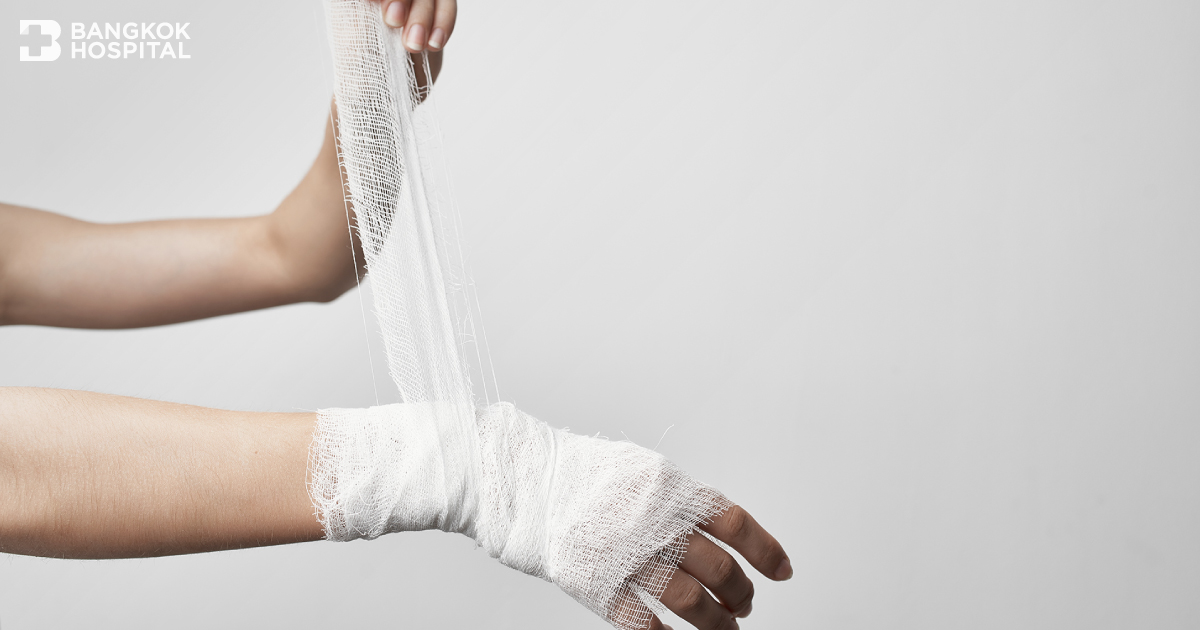While there are many departments and clinics in a big hospital, you might not be aware that there is an Advance Wound Care Center. Dr. Att Nitibhon, director of surgery at Bangkok Hospital, explained the definition of an Advance Wound Care Center as below.
The Advance Wound Care Center focuses on the evaluation and treatment of chronic wounds that do not heal within 4 weeks. Common causes of these wounds are diabetes, pressure ulcers, venous insufficiency, and peripheral arterial disease. You or your loved one will need special care if he or she has a wound that will not heal.
Wounds, in otherwise healthy individuals, usually heal uneventfully on their own. In patients with chronic, non-healing wounds, there is frequently an underlying health problem preventing the wound from healing in a natural fashion. A chronic wound can lead to dangerous complications, but there are a number of treatment options to help avoid more serious problems. This is why you should not ignore a wound that does not heal.
Common causes of chronic wounds
-
Diabetic ulcers
When you have diabetes, blood sugar level is the main factor in how quickly your wound will heal. When blood sugar level is high, it leads to infection, peripheral vascular disease, and prevents nutrients and oxygen from energizing cells. In people with diabetes, wounds tend to heal more slowly and progress more quickly. Peripheral neuropathy can also result from having blood sugar levels that are consistently higher than normal. Over time, damage occurs to the nerves and vessels. This can cause the affected areas to lose sensation. When it happens, you may not be able to feel wounds when they occur. This is one major reason why foot wounds tend to be more common in people with diabetes. In addition, nerve damage is a long-term effect and can even lead to a loss of feeling in your feet. Damaged nerves can feel tingly and painful at first. Nerve damage reduces your sensitivity to foot pain and results in painless wounds that can cause ulcers. Also, dry skin is common in diabetes. Your skin may be more prone to cracking. Moreover, cutting toenail into the corners can lead to ingrown nail. This can also lead to diabetic ulcer. Wounds present a real cause for concern. Catching wounds early is the key to avoiding infections and complications.
-
Pressure ulcers or bedsores
Pressure ulcers are injuries to skin and underlying tissue resulting from prolonged pressure on the skin. People most at risk of pressure ulcers are those with a medical condition, such as stroke and Alzheimer’s disease that limits their ability to change positions or those who spend most of their time in a bed or chair. There are 4 stages of pressure ulcers.
- Stage 1 – A red area on the skin that does not get lighter when you press on it.
- Stage 2 – The skin is broken, leaves an open wound, or looks like a pus-filled blister.
- Stage 3 – The sores have gone through the second layer of skin into the fat tissue.
- Stage 4 – The sore is deep and big. You may be able to see tendons, muscles, and bone.
-
Chronic venous insufficiency
Chronic venous insufficiency is a condition in which blood does not flow normally up through the veins in the legs toward the heart. In normal veins a series of specialized, one-way valves work together, opening to allow blood to flow upward, then closing to keep the blood from flowing back toward the feet. Venous insufficiency occurs when valves are damaged or not functioning properly. People with long-term, untreated venous insufficiency sometimes develop open sores in the skin called venous ulcers. Ulcerations develop in areas where blood collects and pools, as swelling there interferes with the movement of oxygen and nutrients through tissues. Venous ulcers usually appear just above the ankle on the inside of the leg. If they are not treated they can become quickly infected or even gangrenous.
-
Peripheral artery disease
Peripheral arterial disease is the narrowing of the arteries in your arms and legs, limiting blood flow to your muscles. It is most often caused by atherosclerosis. When a sore or wound does not have sufficient blood supply or circulation, it affects your body’s ability to heal the wound and can increase the risk of infection.
After explaining common causes of chronic wounds to us, Dr. Att also leave a take home message for us that prevention is better than cure.
“Patients should control their underlying diseases and prevent a wound from happening. Healthy eating, regular exercise, and self-check such as foot check for patients with diabetes are very important.”
Coping with chronic, non-healing wounds can be both frustrating and time-consuming, but specialized care is important in order to help improve healing and your quality of life. Also, getting an immediate treatment can help prevent chronic wounds to progress further.










